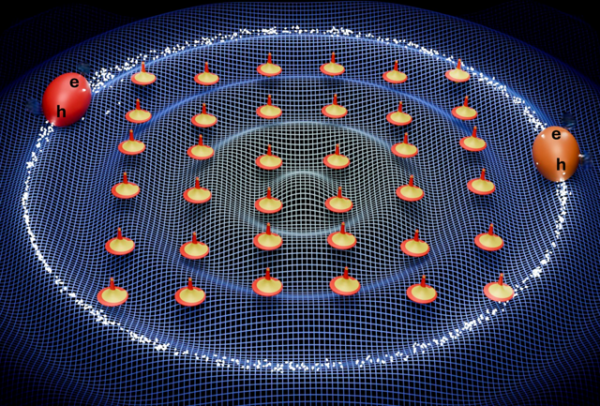
Rendition of the discovery where the excitons (e-h pairs) interact via ripples in the magnetic structure akin to an array of spinning tops generating a wave that affects each other and couples the excitons. Credit: Visakh Menon
Groundbreaking research by physicists at The City College of New York is being credited for a novel discovery regarding the interaction of electronic excitations via spin waves. The finding by the Laboratory for Nano and Micro Photonics (LaNMP) team headed by physicist Vinod Menon could open the door to future technologies and advanced applications such as optical modulators, all-optical logic gates, and quantum transducers. The work is reported in the journal Nature Materials.
The researchers showed the emergence of interaction between electronic excitations (excitons – electron hole pairs) mediated via spin waves in atomically thin (2D) magnets. They demonstrated that the excitons can interact indirectly through magnons (spin waves), which are like ripples or waves in the 2D material’s magnetic structure.
“Think of magnons as tiny flip-flops of atomic magnets inside the crystal. One exciton changes the local magnetism, and that change then influences another exciton nearby. It’s like two floating objects pulling toward each other by disturbing water waves around them,” said Menon.
To demonstrate this, the Menon group utilized a magnetic semiconductor, CrSBr which the group had previously shown to host strong light-matter interaction (Nature, 2023).
Post-doctoral fellows Biswajit Datta and Pratap Chandra Adak led the research along with graduate students Sichao Yu and Agneya Dharmapalan in collaboration with the groups at the CUNY Advanced Science Research Center, University of Chemistry and Technology – Prague, RPTU - Kaiserslautern, Germany and NREL, USA.
“What is especially exciting about this discovery is that the interaction between excitons can be controlled externally using a magnetic field, thanks to the tunable magnetism of 2D materials. That means we can effectively switch the interaction on or off, which is hard to do with other types of interactions,” said Datta.
“One particularly exciting application enabled by this discovery is in the development of quantum transducers - devices that convert quantum signals from one frequency to another, such as from microwave to optical. These are key components for building quantum computers and enabling the quantum internet.” said Adak, another lead author of this work.
The work at CCNY was supported by U.S. Department of Energy – Office of Basic Energy Sciences, The Army Research Office, The National Science Foundation and The Gordon and Betty Moore Foundation.
Citation: Datta, B., Adak, P.C., Yu, S. et al. Magnon-mediated exciton–exciton interaction in a van der Waals antiferromagnet. Nat. Mater. (2025). https://doi.org/10.1038/s41563-025-02183-0
About The City College of New York
Since 1847, The City College of New York has provided a high-quality and affordable education to generations of New Yorkers in a wide variety of disciplines. CCNY embraces its position at the forefront of social change. It is ranked #1 by the Harvard-based Opportunity Insights out of 369 selective public colleges in the United States on the overall mobility index. This measure reflects both access and outcomes, representing the likelihood that a student at CCNY can move up two or more income quintiles. Education research organization Degree Choices ranks CCNY #1 nationally among universities for economic return on investment. In addition, the Center for World University Rankings places CCNY in the top 1.8% of universities worldwide in terms of academic excellence. Labor analytics firm Lightcast puts at $3.2 billion CCNY’s annual economic impact on the regional economy (5 boroughs and 5 adjacent counties) and quantifies the “for dollar” return on investment to students, taxpayers and society. At City College, more than 15,000 students pursue undergraduate and graduate degrees in eight schools and divisions, driven by significant funded research, creativity and scholarship. In 2023, CCNY launched its most expansive fundraising campaign, ever. The campaign, titled “Doing Remarkable Things Together” seeks to bring the College’s Foundation to more than $1 billion in total assets in support of the College mission. CCNY is as diverse, dynamic and visionary as New York City itself. View CCNY Media Kit.
Jay Mwamba
p: 917.892.0374
e:
jmwamba@ccny.cuny.edu